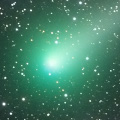
|
Now it is 6.5 mag (Oct. 13, Marco Goiato). It was expected to brighten up to 4-5 mag from autumn to winter. However, the brightness evolution has stopped in September. It will become unobservable soon also in the Southern Hemisphere. In the Northern Hemisphere, it keeps unobservable until late November.
Date(TT) R.A. (2000) Decl. Delta r Elong. m1 Best Time(A, h)
Oct. 10 14 33.54 -34 21.7 1.710 1.067 35 6.6 18:56 ( 58,-15)
Oct. 17 14 30.97 -31 21.0 1.770 0.992 27 6.5 18:47 ( 63,-17)
|
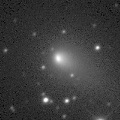
|
It brightened very rapidly. Now it is so bright as 9.7 mag (Oct. 11, Seiichi Yoshida). It is observable at 9-10 mag until next spring in excellent condition in the Northern Hemisphere. It keeps unobservable in the Southern Hemisphere.
Date(TT) R.A. (2000) Decl. Delta r Elong. m1 Best Time(A, h)
Oct. 10 17 7.63 88 8.9 1.888 2.219 95 9.8 18:56 (178, 36)
Oct. 17 16 19.78 84 2.1 1.875 2.194 94 9.7 18:47 (173, 38)
|
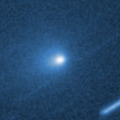
|
Now it is very bright as 9.5 mag (Oct. 14, Marco Goiato). In the Northern Hemisphere, it keeps very low in the evening until mid December. It will be getting lower gradually after this even in the Southern Hemisphere.
Date(TT) R.A. (2000) Decl. Delta r Elong. m1 Best Time(A, h)
Oct. 10 16 15.27 -19 35.6 2.022 1.566 49 10.9 18:56 ( 55, 12)
Oct. 17 16 36.88 -20 41.3 2.049 1.560 47 10.9 18:47 ( 54, 12)
|
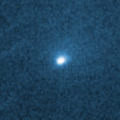
|
It brightened very rapidly. Now it is very bright as 11.1 mag (Oct. 9, Chris Wyatt). It keeps 11-13 mag until February. But it keeps very low in the Northern Hemisphere. It will be getting lower gradually after this even in the Southern Hemisphere.
Date(TT) R.A. (2000) Decl. Delta r Elong. m1 Best Time(A, h)
Oct. 10 16 49.43 -20 47.3 1.738 1.466 57 11.6 18:56 ( 48, 17)
Oct. 17 17 11.09 -22 9.9 1.756 1.449 55 11.5 18:47 ( 47, 16)
|

|
It brightened up to 3.7 mag and became a naked eye comet in mid January in 2015 (Jan. 13, Marek Biely). Now it is fading. But it is bright as 11.4 mag still now (Oct. 5, Katsumi Yoshimoto). In the Northern Hemisphere, it keeps observable for a long time until the comet fades out. It is not observable in the Southern Hemisphere.
Date(TT) R.A. (2000) Decl. Delta r Elong. m1 Best Time(A, h)
Oct. 10 16 25.59 31 17.0 3.909 3.550 61 11.7 18:56 (102, 43)
Oct. 17 16 33.25 29 33.1 4.027 3.622 59 11.9 18:47 (101, 41)
|
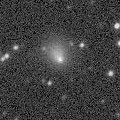
|
Now it is bright as 11.8 mag (Oct. 15, Juan Jose Gonzalez). It will pass close to the earth from spring to summer in 2016, and it is expected to be observable at 6-7 mag in good condition. In the Northern Hemispehre, it keeps observable in excellent condition until winter. In the Southern Hemisphere, it keeps very low until winter.
Date(TT) R.A. (2000) Decl. Delta r Elong. m1 Best Time(A, h)
Oct. 10 5 19.62 42 19.3 2.399 2.933 112 12.1 4:08 (180, 83)
Oct. 17 5 5.36 43 26.4 2.211 2.859 121 11.8 3:27 (180, 82)
|
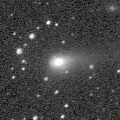
|
Now it is bright as 11.7 mag (Oct. 15, Juan Jose Gonzalez). It keeps bright as 11-12 mag from August to October. In the Northern Hemisphere, it is getting higher gradually, and it keeps observable in good condition after this. In the Southern Hemisphere, it keeps low until November.
Date(TT) R.A. (2000) Decl. Delta r Elong. m1 Best Time(A, h)
Oct. 10 9 53.20 17 59.4 1.805 1.427 52 12.2 4:37 (271, 34)
Oct. 17 10 12.07 16 41.2 1.808 1.469 54 12.3 4:42 (274, 36)
|
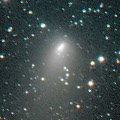
|
It brightened rapidly up to 10.4 mag from July to August (July 18, Maik Meyer). Now it is fading, but it is bright as 13.2 mag still now (Oct. 11, Seiichi Yoshida). It is observable in good condition in the Northern Hemisphere. It is not observable in the Southern Hemisphere.
Date(TT) R.A. (2000) Decl. Delta r Elong. m1 Best Time(A, h)
Oct. 10 19 8.82 45 40.8 1.425 1.825 96 13.0 18:56 (137, 74)
Oct. 17 19 19.77 45 53.3 1.486 1.867 95 13.2 18:47 (135, 73)
|
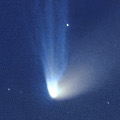
|
It approached to the sun down to 0.3 a.u. on July 6, and brighted up to 3.9 mag (July 6, Thomas Lehmann). Now it is fading. It has already faded down to 12.9 mag (Oct. 3, Chris Wyatt). In the Northern Hemisphere, it keeps observable until the comet fades out. It will not be observable after this in the Northern Hemisphere.
Date(TT) R.A. (2000) Decl. Delta r Elong. m1 Best Time(A, h)
Oct. 10 14 39.93 -48 30.0 2.571 2.030 47 13.0 18:56 ( 45,-21)
Oct. 17 15 0.60 -49 51.1 2.717 2.139 45 13.4 18:47 ( 43,-21)
|

|
Now it is bright as 12.8 mag (Oct. 15, Juan Jose Gonzalez). It keeps 13 mag for a long time from 2015 autumn to 2016 summer. In the Northern Hemispehre, it keeps observable in good condition for a long time. It keeps unobservable in the Southern Hemisphere.
Date(TT) R.A. (2000) Decl. Delta r Elong. m1 Best Time(A, h)
Oct. 10 7 28.34 66 57.5 2.886 3.104 93 13.9 4:37 (197, 55)
Oct. 17 7 44.33 70 3.6 2.786 3.068 96 13.8 4:42 (192, 53)
|

|
Outburst occured on Sept. 22. It is bright as 12.5 mag still now (Oct. 4, Thomas Lehmann).
Date(TT) R.A. (2000) Decl. Delta r Elong. m1 Best Time(A, h)
Oct. 10 17 31.76 -29 1.0 6.307 6.000 67 13.8 18:56 ( 35, 16)
Oct. 17 17 35.97 -28 54.8 6.405 5.998 61 13.9 18:47 ( 38, 14)
|
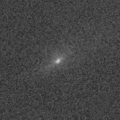
|
Now it is 12.8 mag (Sept. 21, Hiroshi Abe). In the Northern Hemisphere, it is appearing in the morning sky. It keeps observable after this while the comet will be fading. It is not observable in the Southern Hemisphere until January when the comet will fade down to 16 mag.
Date(TT) R.A. (2000) Decl. Delta r Elong. m1 Best Time(A, h)
Oct. 10 11 38.87 25 21.8 2.693 1.993 37 14.0 4:37 (250, 16)
Oct. 17 11 54.82 24 28.9 2.702 2.043 40 14.2 4:42 (253, 19)
|
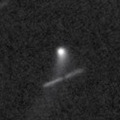
|
Now it is 15.1 mag (Sept. 13, Taras Prystavski). It will brighten up to 14 mag from 2015 to 2016. It keeps observable in good condition for a while.
Date(TT) R.A. (2000) Decl. Delta r Elong. m1 Best Time(A, h)
Oct. 10 1 56.80 14 43.1 3.222 4.190 163 14.3 0:46 ( 0, 70)
Oct. 17 1 43.73 14 54.2 3.204 4.195 172 14.3 0:06 ( 0, 70)
|
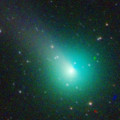
|
It brightened up to 6.0 mag in mid May (May 14, Chris Wyatt). Now it is fading. It has already faded down to 14.5 mag (Oct. 11, Seiichi Yoshida). In the Northern Hemisphere, it keeps observable in good condition after this while the comet will be fading. It locates somewhat low in the Southern Hemisphere.
Date(TT) R.A. (2000) Decl. Delta r Elong. m1 Best Time(A, h)
Oct. 10 8 38.33 22 44.0 2.564 2.415 70 14.4 4:37 (277, 51)
Oct. 17 8 34.63 23 59.3 2.511 2.504 78 14.5 4:42 (282, 59)
|

|
Now it is 14.4 mag (Sept. 20, Yasukazu Ikari). Distant object, but it keeps observable at 14-15 mag for a long time from 2015 to 2016.
Date(TT) R.A. (2000) Decl. Delta r Elong. m1 Best Time(A, h)
Oct. 10 21 9.96 -6 14.8 4.568 5.159 121 14.4 19:55 ( 0, 49)
Oct. 17 21 10.91 -6 38.6 4.646 5.143 114 14.4 19:29 ( 0, 48)
|
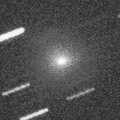
|
It brightened rapidly in mid August, and brightened up to 10.8 mag (Sept. 13, Sandor Szabo). Secondary component H also brightened up to 14.8 mag (Sept. 13, Thomas Lehmann). Now it is 13.1 mag (Oct. 13, Thomas Lehmann). It will fade out very rapidly after this. In the Northern Hemisphere, it keeps observable in good condition in the morning sky. In the Southern Hemisphere, it keeps locating extremely low from summer to autumn.
Date(TT) R.A. (2000) Decl. Delta r Elong. m1 Best Time(A, h)
Oct. 10 9 56.97 6 4.8 1.454 1.067 47 14.5 4:37 (282, 26)
Oct. 17 10 13.33 3 27.8 1.503 1.142 49 15.2 4:42 (287, 28)
|
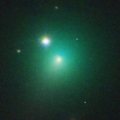
|
It is fading, but bright as 12.7 mag still now (Sept. 17, Uwe Pilz). It keeps observable in good condition until winter when the comet becomes fainter than 18 mag.
Date(TT) R.A. (2000) Decl. Delta r Elong. m1 Best Time(A, h)
Oct. 10 2 36.27 11 45.3 1.343 2.289 155 14.6 1:25 ( 0, 67)
Oct. 17 2 28.45 11 20.0 1.360 2.335 164 14.9 0:50 ( 0, 66)
|

|
Appearing in the morning sky in the Northern Hemisphere. It will be observable after December in the Southern Hemisphere. It is expected to brighten up to 13 mag from winter to spring. It will be observable in excellent condition in the Southern Hemisphere. But it locates somewhat low in the Northern Hemisphere.
Date(TT) R.A. (2000) Decl. Delta r Elong. m1 Best Time(A, h)
Oct. 10 11 33.87 4 36.9 3.159 2.284 24 15.0 4:37 (268, 6)
Oct. 17 11 47.24 3 6.1 3.110 2.270 27 14.9 4:42 (273, 9)
|
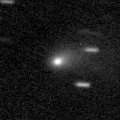
|
First return of a periodic comet discovered in 1994. It brightened up to 13.8 mag from summer to autumn (Sept. 7, Taras Prystavski). Now it is fading, but it is bright as 15.1 mag still now (Oct. 2, Katsumi Yoshimoto). It is observable in excellent condition in the Southern Hemisphere. It locates somewhat low in the Northern Hemisphere.
Date(TT) R.A. (2000) Decl. Delta r Elong. m1 Best Time(A, h)
Oct. 10 22 32.31 -30 53.9 1.699 2.451 128 15.0 21:18 ( 0, 24)
Oct. 17 22 32.55 -29 23.7 1.754 2.449 123 15.1 20:50 ( 0, 26)
|
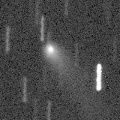
|
Now it is 14.4 mag (Sept. 13, Taras Prystavski). It keeps 15 mag for a long time from 2014 to 2015. It is observable in excellent condition in the Northern Hemisphere. It locates low in the Southern Hemisphere.
Date(TT) R.A. (2000) Decl. Delta r Elong. m1 Best Time(A, h)
Oct. 10 1 40.69 45 21.5 3.476 4.289 139 15.0 0:30 (180, 80)
Oct. 17 1 31.19 46 4.7 3.478 4.315 142 15.1 23:48 (180, 79)
|
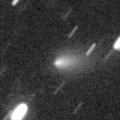
|
It was so faint as 20.0 mag in August (Aug. 17, Hidetaka Sato). However, it brightened by 6 mag in outburst in mid September. Now it is 15.6 mag (Oct. 2, Katsumi Yoshimoto). It keeps observable in excellent condition for a while.
Date(TT) R.A. (2000) Decl. Delta r Elong. m1 Best Time(A, h)
Oct. 10 4 54.49 4 46.7 1.423 2.124 121 15.1 3:43 ( 0, 60)
Oct. 17 4 53.54 3 30.9 1.405 2.167 128 15.3 3:14 ( 0, 59)
|
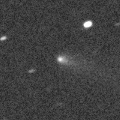
|
Now it is 14.6 mag (Sept. 18, Katsumi Yoshimoto). It keeps observable at 15 mag in good condition for a while.
Date(TT) R.A. (2000) Decl. Delta r Elong. m1 Best Time(A, h)
Oct. 10 2 32.03 6 47.3 1.159 2.115 157 15.2 1:21 ( 0, 62)
Oct. 17 2 29.19 6 2.0 1.141 2.117 163 15.2 0:50 ( 0, 61)
|

|
Now it is 14.7 mag (Sept. 6, Sandor Szabo). In 2015, it keeps 13-14 mag and will be observable in good condition for a long time.
Date(TT) R.A. (2000) Decl. Delta r Elong. m1 Best Time(A, h)
Oct. 10 19 28.71 -14 19.0 3.631 3.856 95 15.3 18:56 ( 13, 40)
Oct. 17 19 34.16 -14 30.5 3.757 3.884 89 15.4 18:47 ( 17, 39)
|
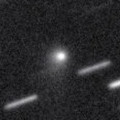
|
Now it is 14.9 mag (Sept. 13, Sandor Szabo). It keeps 15-16 mag for a long time until 2016. It keeps observable in excellent condition in the Northern Hemisphere. It keeps unobservable in the Southern Hemisphere.
Date(TT) R.A. (2000) Decl. Delta r Elong. m1 Best Time(A, h)
Oct. 10 5 37.86 63 42.6 4.842 5.185 104 15.6 4:27 (180, 61)
Oct. 17 5 36.52 65 16.9 4.770 5.186 109 15.5 3:58 (180, 60)
|

|
It brightened up to 13 mag in 2014. Now it is 15.2 mag (Sept. 12, Sandor Szabo). It will be fading slowly after this. It is observable at 16 mag in excellent condition from summer to winter in 2015.
Date(TT) R.A. (2000) Decl. Delta r Elong. m1 Best Time(A, h)
Oct. 10 1 19.81 0 8.5 2.945 3.937 171 16.1 0:09 ( 0, 55)
Oct. 17 1 15.19 -0 9.6 2.966 3.952 170 16.1 23:32 ( 0, 55)
|
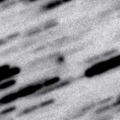
|
It brightened up to 16.4 mag in 2014 (Nov. 14, J. F. Hernandez). Now it is 17.2 mag (Aug. 27, D. Buczynski). It will be observable at 16 mag again from summer to autumn in 2015. However, it is fainter than this ephemeris recently.
Date(TT) R.A. (2000) Decl. Delta r Elong. m1 Best Time(A, h)
Oct. 10 4 26.08 28 30.7 1.858 2.581 126 16.1 3:14 ( 0, 84)
Oct. 17 4 24.51 28 31.7 1.818 2.608 133 16.1 2:45 ( 0, 84)
|
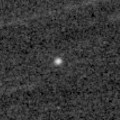
|
Now it is 16.7mag (Sept. 26, C. Bell). It is expected to brighten rapidly, and to be observable at 14.5 mag in good condition in autumn.
Date(TT) R.A. (2000) Decl. Delta r Elong. m1 Best Time(A, h)
Oct. 10 4 40.45 -8 33.8 0.750 1.541 122 16.3 3:28 ( 0, 46)
Oct. 17 4 50.39 -9 5.0 0.707 1.523 125 16.1 3:11 ( 0, 46)
|
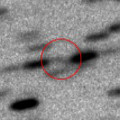
|
Now it is 18.0 mag (Sept. 24, Jean-Gabriel Bosch). It will brighten up to 11 mag from spring to summer in 2016. In the Northern Hemisphere, it keeps observable in good condition while the comet will be brightening. It locates somewhat low in the Southern Hemisphere.
Date(TT) R.A. (2000) Decl. Delta r Elong. m1 Best Time(A, h)
Oct. 10 5 59.21 19 57.8 2.473 2.916 106 16.3 4:37 (351, 75)
Oct. 17 6 2.49 19 51.5 2.344 2.876 112 16.1 4:23 ( 0, 75)
|
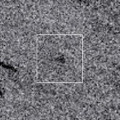
|
No observations have been reported after November in 2014. Current brightness is uncertain. It must keep 16 mag for a long time from 2015 autumn to 2016 summer. It keeps observable in excellent condition in the Southern Hemisphere. It locates low in the Northern Hemisphere.
Date(TT) R.A. (2000) Decl. Delta r Elong. m1 Best Time(A, h)
Oct. 10 1 46.64 -34 0.8 2.075 2.897 138 16.2 0:36 ( 0, 21)
Oct. 17 1 22.40 -37 4.2 2.081 2.864 133 16.2 23:37 ( 0, 18)
|

|
First return of a periodic comet which brightened up to 8 mag in major outburst in 2010. It will be observable in excellent condition from winter to spring. Now it is not detected, fainter than 20 mag (Oct. 2, Jean-Francois Soulier).
Date(TT) R.A. (2000) Decl. Delta r Elong. m1 Best Time(A, h)
Oct. 10 7 53.17 30 55.8 1.904 2.021 81 16.7 4:37 (270, 64)
Oct. 17 8 8.99 30 41.1 1.799 1.985 85 16.2 4:42 (273, 67)
|

|
It brightened up to 6.9 mag in 2014 autumn (Oct. 17, Marco Goiato). Now it is fading. It has already faded down to 15.7 mag (Oct. 2, Katsumi Yoshimoto). In the Southern Hemisphere, it keeps observable in good condition until the comet fades out. In the Northern Hemisphere, it keeps observable until winter, but it locates somewhat low.
Date(TT) R.A. (2000) Decl. Delta r Elong. m1 Best Time(A, h)
Oct. 10 23 2.33 -29 9.7 4.455 5.205 134 16.2 21:47 ( 0, 26)
Oct. 17 22 55.71 -29 4.0 4.605 5.272 127 16.3 21:13 ( 0, 26)
|

|
First return of a periodic comet discovered in 2003. Now it is 18.1 mag (Oct. 11, J.-F. Soulier). It will approach to the earth from autumn to winter, and it is expected to brighten up to 15 mag and observable in excellent condition. But actually, it is somewhat fainter than this ephemeris.
Date(TT) R.A. (2000) Decl. Delta r Elong. m1 Best Time(A, h)
Oct. 10 4 45.05 -6 55.4 1.024 1.771 122 16.5 3:33 ( 0, 48)
Oct. 17 4 51.09 -6 29.9 0.958 1.746 126 16.3 3:11 ( 0, 49)
|

|
Now it is 15.8 mag (Sept. 15, Taras Prystavski). It will be unobservable in mid November.
Date(TT) R.A. (2000) Decl. Delta r Elong. m1 Best Time(A, h)
Oct. 10 17 34.91 -26 57.0 8.713 8.395 68 16.6 18:56 ( 36, 18)
Oct. 17 17 35.69 -27 10.3 8.856 8.427 61 16.6 18:47 ( 39, 16)
|
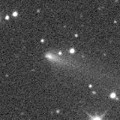
|
Now it is 15.5 mag (Sept. 20, Michael Jager). It keeps observable in good condition for a while. But it will be fading after this, and will be fainter than 18 mag in November.
Date(TT) R.A. (2000) Decl. Delta r Elong. m1 Best Time(A, h)
Oct. 10 0 6.41 0 43.9 1.150 2.132 165 16.6 22:51 ( 0, 56)
Oct. 17 0 3.22 0 9.1 1.211 2.166 157 16.8 22:20 ( 0, 55)
|
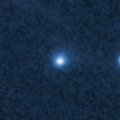
|
Now it is 16.8 mag (Sept. 20, Michael Jager). It will be fading after this. It will be fainter than 18 mag at the end of 2015.
Date(TT) R.A. (2000) Decl. Delta r Elong. m1 Best Time(A, h)
Oct. 10 23 28.49 -8 20.6 1.542 2.474 152 16.8 22:13 ( 0, 47)
Oct. 17 23 27.40 -8 34.1 1.586 2.475 145 16.8 21:45 ( 0, 47)
|
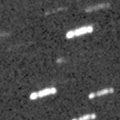
|
Now it is 16.5 mag (Sept. 24, J. V. Scotti). It is observable at 17 mag in excellent condition in autumn.
Date(TT) R.A. (2000) Decl. Delta r Elong. m1 Best Time(A, h)
Oct. 10 5 58.51 4 48.3 1.221 1.774 105 16.9 4:37 (355, 60)
Oct. 17 6 6.96 2 16.6 1.182 1.785 109 16.9 4:27 ( 0, 57)
|

|
Now it is 17.7 mag (Sept. 24, Jean-Gabriel Bosch). It will brighten up to 14 mag in 2016 summer. But it is not observable at the highlight. It keeps observable until March while the comet will be brightening gradually up to 15-16 mag.
Date(TT) R.A. (2000) Decl. Delta r Elong. m1 Best Time(A, h)
Oct. 10 0 33.90 -5 18.6 1.729 2.711 166 17.2 23:18 ( 0, 50)
Oct. 17 0 28.76 -6 6.1 1.725 2.680 159 17.1 22:46 ( 0, 49)
|
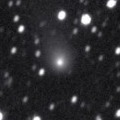
|
Now it is 15.5 mag (Sept. 6, Sandor Szabo). It is fading, but it is a bit brighter than this ephemeris. The fragments B and C are already fainter than 20 mag (June 12, Takaaki Oribe).
Date(TT) R.A. (2000) Decl. Delta r Elong. m1 Best Time(A, h)
Oct. 10 22 47.13 -0 1.7 5.727 6.582 146 17.1 21:32 ( 0, 55)
Oct. 17 22 43.61 -0 55.4 5.848 6.628 138 17.2 21:01 ( 0, 54)
|

|
Now it is 16.5 mag (Sept. 8, Jean-Francois Soulier). It has brightened in outburst up to 14 mag twice, in 2006 January and 2011 May. It is around the perihelion now. It keeps observable at 17 mag for a long time after this.
Date(TT) R.A. (2000) Decl. Delta r Elong. m1 Best Time(A, h)
Oct. 10 23 6.90 -5 25.3 4.992 5.874 149 17.3 21:52 ( 0, 50)
Oct. 17 23 5.34 -5 38.7 5.060 5.879 142 17.3 21:23 ( 0, 49)
|
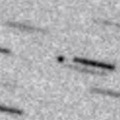
|
Now it is 16.3 mag (Sept. 27, E. Bryssinck). It is observable in good condition in the Northern Hemisphere. It is not observable in the Southern Hemisphere.
Date(TT) R.A. (2000) Decl. Delta r Elong. m1 Best Time(A, h)
Oct. 10 9 25.17 39 49.5 1.698 1.608 67 17.3 4:37 (247, 48)
Oct. 17 9 45.12 40 2.3 1.695 1.656 70 17.4 4:42 (247, 50)
|
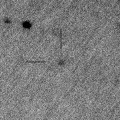
|
Now it is 18.8 mag (Sept. 24, A. Maury, J.-F. Soulier, T. Noel, J.-G. Bosch). Now it is near the aphelion. It is observable at 17 mag in good condition from autumn to winter.
Date(TT) R.A. (2000) Decl. Delta r Elong. m1 Best Time(A, h)
Oct. 10 3 52.37 16 27.6 3.546 4.326 136 17.5 2:41 ( 0, 72)
Oct. 17 3 49.83 16 21.1 3.471 4.318 144 17.4 2:11 ( 0, 71)
|

|
It keeps 16.5 mag for a long time in 2016, and it will be observable in excellent condition in the Southern Hemisphere. It is hardly observable in the Northern Hemisphere.
Date(TT) R.A. (2000) Decl. Delta r Elong. m1 Best Time(A, h)
Oct. 10 9 2.74 -37 24.4 4.258 3.888 61 17.5 4:37 (323, 5)
Oct. 17 9 2.75 -39 33.6 4.160 3.857 65 17.5 4:42 (330, 7)
|
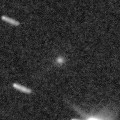
|
Now it is 16.7 mag (Sept. 19, J. Gonzalez). It was expected to brighten rapidly, and to be observable at 16 mag in good condition from summer to winter. But actually, it is much fainter than predicted.
Date(TT) R.A. (2000) Decl. Delta r Elong. m1 Best Time(A, h)
Oct. 10 22 37.03 -9 33.0 1.328 2.197 141 17.5 21:22 ( 0, 46)
Oct. 17 22 33.23 -8 29.8 1.357 2.169 133 17.5 20:51 ( 0, 47)
|
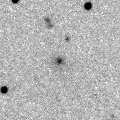
|
Now it is 15.8 mag (Sept. 18, Catalina Sky Survey). It keeps observable in good condition until the comet fades out. In 2014, it must have been observable at 14 mag in good condition in the Southern Hemisphere.
Date(TT) R.A. (2000) Decl. Delta r Elong. m1 Best Time(A, h)
Oct. 10 0 12.74 2 33.4 3.453 4.434 167 17.7 22:57 ( 0, 58)
Oct. 17 0 8.42 2 36.3 3.538 4.486 159 17.8 22:25 ( 0, 58)
|

|
First return of a periodic comet discovered in 1998. Now it is 17.9 mag (Oct. 3, J. V. Scotti). It will be observable at 17.5 mag from autumn to winter.
Date(TT) R.A. (2000) Decl. Delta r Elong. m1 Best Time(A, h)
Oct. 10 20 58.05 -18 47.9 1.367 2.009 115 17.8 19:44 ( 0, 36)
Oct. 17 21 1.98 -17 8.5 1.415 1.988 109 17.7 19:20 ( 0, 38)
|
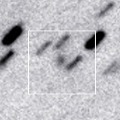
|
It keeps 17.5 mag for a long time from 2016 to 2019. It keeps locating near by the equator.
Date(TT) R.A. (2000) Decl. Delta r Elong. m1 Best Time(A, h)
Oct. 10 8 11.10 0 11.8 10.579 10.318 72 17.8 4:37 (309, 42)
Oct. 17 8 12.67 -0 0.2 10.459 10.304 78 17.7 4:42 (318, 47)
|

|
It will pass the perihelion in 2019. However, it has not been brightening since the discovery in 2010. Now it is 17.9 mag (Sept. 11, E. Bryssinck). It keeps observable in excellent condition from autumn to next spring in the Northern Hemisphere. It is not observable in the Southern Hemisphere.
Date(TT) R.A. (2000) Decl. Delta r Elong. m1 Best Time(A, h)
Oct. 10 3 48.44 46 32.6 10.436 11.051 125 17.8 2:37 (180, 78)
Oct. 17 3 46.15 46 51.4 10.337 11.026 131 17.8 2:07 (180, 78)
|

|
Now it is 17.8 mag (Sept. 11, A. Diepvens). It keeps 17.5 mag for a long time from 2014 to 2015. It is observable in excellent condition in the Northern Hemisphere. It is not observable in the Southern Hemisphere.
Date(TT) R.A. (2000) Decl. Delta r Elong. m1 Best Time(A, h)
Oct. 10 21 46.73 45 45.8 4.162 4.777 122 17.9 20:32 (180, 79)
Oct. 17 21 47.42 44 11.2 4.217 4.811 121 17.9 20:05 (180, 81)
|

|
It was expected to approach to the earth down to 0.2 a.u. and brighten up to 15 mag from August to September. But actually, it is so faint as 19.0 mag, much fainter than predicted (Oct. 1, Michael Jager).
Date(TT) R.A. (2000) Decl. Delta r Elong. m1 Best Time(A, h)
Oct. 10 22 2.65 4 21.3 0.397 1.313 135 20.6 20:50 ( 0, 59)
Oct. 17 22 25.53 4 58.0 0.474 1.374 135 21.1 20:45 ( 0, 60)
|
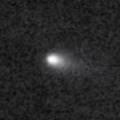
|
It brightened up to 15.9 mag in June as predicted (June 23, Ken-ichi Kadota). It was expected to be observable at 13 mag in good condition from summer to autumn. However, Jean-Gabriel Bosch detected the comet became disintegrating in July. Now it is so faint as 19.3 mag (Aug. 26, W. Hasubick). The fragment D and B are also observed as 19.0 mag (Sept. 20, Michael Jager) and 20.9 mag (Aug. 21, Pan-STARRS 1, Haleakala) respectively.
Date(TT) R.A. (2000) Decl. Delta r Elong. m1 Best Time(A, h)
Oct. 10 2 21.38 3 14.3 0.820 1.790 159 23.9 1:10 ( 0, 58)
Oct. 17 2 17.38 3 16.5 0.829 1.812 165 24.7 0:39 ( 0, 58)
|
|
![]()
 318P/2014 M6 ( McNaught-Hartley )
318P/2014 M6 ( McNaught-Hartley ) C/2014 N3 ( NEOWISE )
C/2014 N3 ( NEOWISE ) 205P/Giacobini
205P/Giacobini 61P/Shajn-Schaldach
61P/Shajn-Schaldach C/2012 F3 ( PanSTARRS )
C/2012 F3 ( PanSTARRS ) C/2013 V4 ( Catalina )
C/2013 V4 ( Catalina ) 117P/Helin-Roman-Alu 1
117P/Helin-Roman-Alu 1 44P/Reinmuth 2
44P/Reinmuth 2 230P/LINEAR
230P/LINEAR 81P/Wild 2
81P/Wild 2 C/2014 W5 ( Lemmon-PanSTARRS )
C/2014 W5 ( Lemmon-PanSTARRS ) P/2010 V1 ( Ikeya-Murakami )
P/2010 V1 ( Ikeya-Murakami ) C/2012 K1 ( PanSTARRS )
C/2012 K1 ( PanSTARRS ) 329P/2015 T1 ( LINEAR-Catalina )
329P/2015 T1 ( LINEAR-Catalina ) C/2010 S1 ( LINEAR )
C/2010 S1 ( LINEAR ) 57P/du Toit-Neujmin-Delporte
57P/du Toit-Neujmin-Delporte 151P/Helin
151P/Helin P/2015 Q1 ( Scotti )
P/2015 Q1 ( Scotti ) 118P/Shoemaker-Levy 4
118P/Shoemaker-Levy 4 C/2011 J2 ( LINEAR )
C/2011 J2 ( LINEAR ) 174P/(60558) 2000 EC98 ( Echeclus )
174P/(60558) 2000 EC98 ( Echeclus ) 162P/Siding Spring
162P/Siding Spring 74P/Smirnova-Chernykh
74P/Smirnova-Chernykh C/2015 B2 ( PanSTARRS )
C/2015 B2 ( PanSTARRS ) 50P/Arend
50P/Arend C/2015 K1 ( MASTER )
C/2015 K1 ( MASTER ) 328P/2015 S1 ( LONEOS-Tucker )
328P/2015 S1 ( LONEOS-Tucker ) C/2014 B1 ( Schwartz )
C/2014 B1 ( Schwartz ) C/2010 U3 ( Boattini )
C/2010 U3 ( Boattini ) C/2013 G3 ( PanSTARRS )
C/2013 G3 ( PanSTARRS ) 320P/2015 HC10 ( McNaught )
320P/2015 HC10 ( McNaught ) 51P/Harrington
51P/Harrington![]()











































